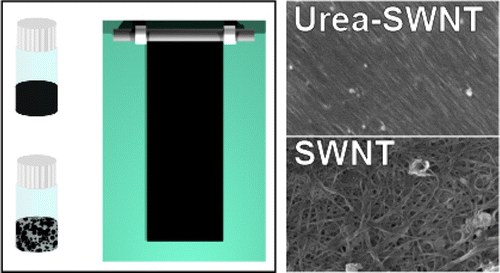
Final-year graduate student Seyla Azoz, in Lisa Pfefferle’s lab, through a collaboration with the labs of Julie Zimmerman and Judy Cha, both of Yale Engineering, and James Kikkawa from UPenn, present a unique method to produce thin conductive films of single-walled carbon nanotubes. The article was recently published in Langmuir.
Highly Conductive Single-Walled Carbon Nanotube Thin Film Preparation by Direct Alignment on Substrates from Water Dispersions
Seyla Azoz †, Annemarie L. Exarhos ‡, Analisse Marquez †, Leanne M. Gilbertson †, Siamak Nejati †,Judy J. Cha §, Julie B. Zimmerman †, James M. Kikkawa ‡, and Lisa D. Pfefferle *†
Abstract:
A safe, scalable method for producing highly conductive aligned films of single-walled carbon nanotubes (SWNTs) from water suspensions is presented. While microfluidic assembly of SWNTs has received significant attention, achieving desirable SWNT dispersion and morphology in fluids without an insulating surfactant or toxic superacid is challenging. We present a method that uniquely produces a noncorrosive ink that can be directly applied to a device in situ, which is different from previous fabrication techniques. Functionalized SWNTs (f-SWNTs) are dispersed in an aqueous urea solution to leverage binding between the amine group of urea and the carboxylic acid group of f-SWNTs and obtain urea-SWNT. Compared with SWNTs dispersed using conventional methods (e.g., superacid and surfactants), the dispersed urea-SWNT aggregates have a higher aspect ratio with a rodlike morphology as measured by light scattering. The Mayer rod technique is used to prepare urea-SWNT, highly aligned films (two-dimensional nematic order parameter of 0.6, 5 μm spot size, via polarized Raman) with resistance values as low as 15–1700 Ω/sq in a transmittance range of 2–80% at 550 nm. These values compete with the best literature values for conductivity of SWNT-enabled thin films. The findings offer promising opportunities for industrial applications relying on highly conductive thin SWNT films.